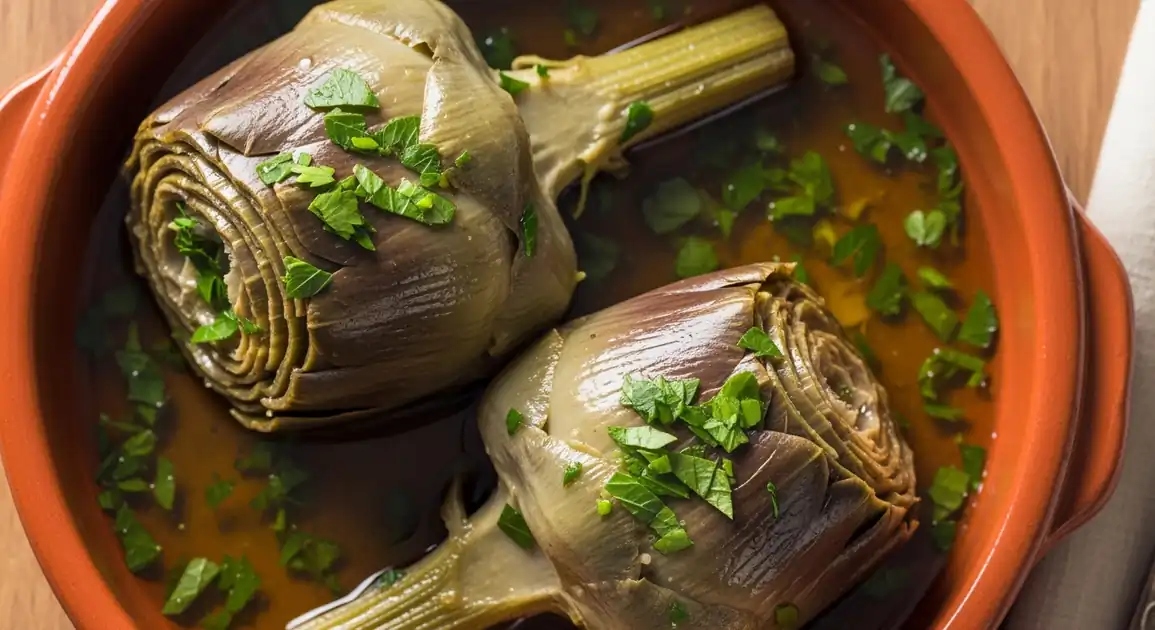Carciofi alla Romana (Roman-Style Artichokes)
Carciofi alla Romana

Description
Carciofi alla Romana is primarily a dish of Rome and the surrounding Lazio region. While known throughout Italy, finding the truly authentic version using Romanesco artichokes and mentuccia is easiest in its home region, especially during the late winter and spring harvesting season.
Dietary Information
Serving information
Serving style
Served whole, usually stem-up or on its side, on a small plate as an appetizer or side dish. Often drizzled with its cooking liquid.
Quick facts
Restaurant lunch (12:30 PM - 3 PM) and dinner (7:30 PM - 11 PM). Market hours typically mornings.
Safety Tips
What to Look For
-
Served warm or room temperature (as intended)
Should be served freshly cooked and warm, or intentionally prepared for a room-temperature antipasto. Avoid suspiciously cold/hot spots suggesting poor reheating.
-
Tender texture throughout (heart and stem easily pierced with a fork)
Properly braised artichokes should be very tender. Toughness indicates undercooking.
-
Fresh, vibrant appearance (green/purple hues, not grey or overly brown)
Indicates fresh artichokes were used and cooked properly. Oxidation (greying) can occur but excessive browning or paleness is undesirable.
-
Clean restaurant environment
General cleanliness of the eatery reflects overall hygiene standards.
-
Evidence of fresh herbs
Visible parsley/mentuccia suggests authentic preparation.
What to avoid
-
Mushy or falling apart texture
Indicates the artichokes were overcooked.
-
Tough, fibrous leaves or stem
Sign of undercooking or poor quality/out-of-season artichokes.
-
Excessive oiliness or wateriness
Should be moist from braising liquid/oil, but not swimming in grease or bland watery broth.
-
Served suspiciously fast (if not explicitly an antipasto)
May indicate reheating rather than fresh braising, potentially affecting quality.
-
Artichokes offered far outside the typical season (late winter/spring)
Likely made with frozen or lower quality imported artichokes, affecting taste and authenticity.
Price information
Price range
Budget tips
- Prices are generally lower in traditional trattorias outside the main tourist centers.
- Ordering it as a 'contorno' (side dish) might be slightly cheaper than as an 'antipasto' (appetizer).
- Market stalls might offer prepared ones for less than restaurants.
Value indicators
- Use of large, tender Romanesco artichokes.
- Clear flavor of fresh herbs, especially mentuccia.
- Served perfectly tender.
- Fair price for the season and quality.
Where to Find This Dish
Lazio Region
Best experienced within its home region, where ingredients are local and preparation is traditional.
Rome, Towns in Castelli Romani
Lunch, Dinner (during season)
Traditional Food Markets
Markets in Rome sell fresh Romanesco artichokes, and sometimes prepared ones.
Campo de' Fiori (Rome), Testaccio Market (Rome)
Morning market hours (during season)
Vendor Tips
- Visit during spring (March/April) for the best chance of finding prime Carciofi alla Romana.
- Look for menus specifying 'Carciofi Romaneschi' for authenticity.
- Don't confuse it with Carciofi alla Giudia (deep-fried).
How to Order
Regional Variations
-
Carciofi alla Giudia
(Carciofi alla Giudia)
Roman-Jewish style artichokes, deep-fried twice until crispy and flower-like. A completely different preparation and texture from Romana.
-
Herb Variations
(N/A)
While parsley and mentuccia are traditional, some cooks might use only parsley or substitute regular mint if mentuccia is unavailable (though less authentic).
-
With Potatoes
(Carciofi e Patate)
Sometimes artichokes are braised alongside potatoes in a similar style, making a more substantial side dish.
Cultural context
History
Artichokes have been cultivated in the Lazio region around Rome since ancient times. Carciofi alla Romana is a staple of 'cucina povera' (peasant cooking), making delicious use of the abundant local spring harvest. The Romanesco artichoke variety (also called 'cimarolo' or 'mammola'), known for its tenderness and lack of a hairy choke, is particularly suited for this whole-braised preparation. The dish reflects the Roman love for seasonal vegetables prepared simply to highlight their natural flavor, enhanced by local herbs like mentuccia.
Local significance
Represents Roman culinary tradition, emphasizing seasonal, local produce prepared simply. A beloved herald of spring.
Eating customs
- Eaten slowly, savoring each leaf and the heart.
- Requires some manual dexterity (pulling leaves).
- Using bread ('fare la scarpetta') to mop up the flavorful cooking liquid is encouraged.